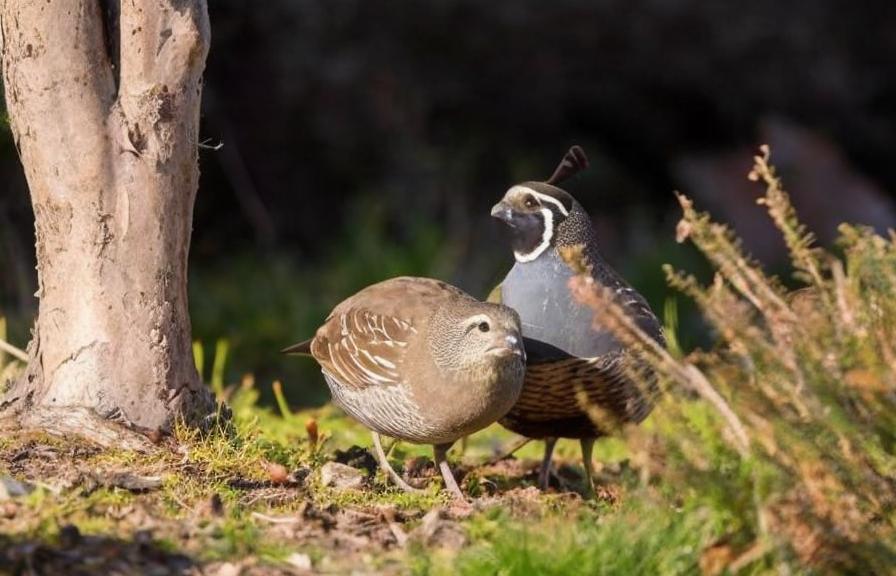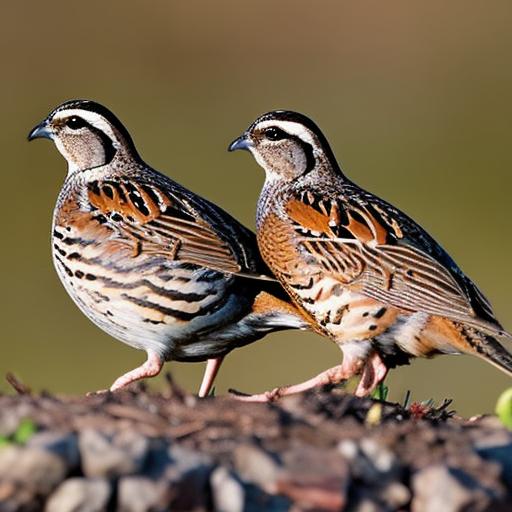Quail are small, ground-dwelling birds that require adequate space to thrive and exhibit natural behaviors. When considering the space requirements for quail, it’s important to understand their natural habitat and behavior in the wild. Quail are known for their ground-dwelling habits and prefer to forage for food on the ground. They are also social birds that live in groups called coveys. In the wild, quail have access to a large area for foraging, dust bathing, and nesting. Therefore, when keeping quail in captivity, it’s essential to provide them with enough space to exhibit these natural behaviors.
In general, quail require a minimum of 1 square foot of space per bird in indoor housing and at least 2-3 square feet per bird in outdoor housing. However, these are just minimum requirements, and providing more space is always beneficial for the birds’ well-being. When determining the space needs for quail, it’s important to consider factors such as the breed of quail, the purpose of keeping them (e.g., for eggs or meat production), and the overall welfare of the birds. By understanding the natural habitat and behavior of quail, as well as considering these factors, it becomes easier to provide the appropriate space for quail in both indoor and outdoor housing setups.
Key Takeaways
- Quail require at least 1 square foot of space per bird in indoor housing
- Factors to consider when determining quail space needs include the size of the birds, their behavior, and the type of housing
- Indoor housing for quail should include proper ventilation, lighting, and protection from predators
- Outdoor housing for quail should provide access to fresh air, sunlight, and protection from predators
- To maximize space for quail, consider using vertical space, providing ample perches, and using stackable cages or coops
Factors to Consider When Determining Quail Space Needs
When determining the space needs for quail, there are several factors to consider to ensure the birds’ well-being and productivity. Firstly, the breed of quail plays a significant role in determining their space requirements. Different breeds of quail may have varying sizes and behavioral patterns, which can influence the amount of space they need to thrive. For example, larger breeds such as Coturnix quail may require more space compared to smaller breeds like Bobwhite quail.
Secondly, the purpose of keeping quail also influences their space needs. If the quail are being kept for egg production, they will need enough space to lay eggs comfortably and exhibit nesting behaviors. On the other hand, if the quail are being raised for meat production, they will need space to move around and exercise to ensure healthy growth and development.
Additionally, considering the overall welfare of the birds is crucial when determining their space needs. Providing adequate space allows quail to exhibit natural behaviors such as foraging, dust bathing, and socializing within a covey. It also helps reduce stress and aggression among the birds, leading to a healthier and more productive flock.
By taking into account these factors, quail owners can ensure that they provide the appropriate amount of space for their birds, leading to better welfare and productivity.
Indoor Housing Requirements for Quail
When it comes to indoor housing for quail, providing enough space is crucial for the birds’ well-being and productivity. Quail should be housed in a well-ventilated area with adequate space to move around, forage, and exhibit natural behaviors. The indoor housing setup should include nesting boxes or areas for egg-laying, perches or platforms for roosting, and a designated area for dust bathing.
In terms of space requirements, quail should have a minimum of 1 square foot per bird in indoor housing. However, providing more space is always beneficial for the birds’ welfare. The indoor housing setup should also allow for easy access to food and water, as well as proper waste management to maintain a clean and healthy environment for the birds.
It’s important to consider the layout and design of the indoor housing to ensure that it meets the specific needs of the quail. Providing hiding spots and areas for privacy can help reduce stress and aggression among the birds. Additionally, maintaining a consistent lighting schedule can help regulate the birds’ behavior and reproductive cycles.
Overall, indoor housing for quail should prioritize providing enough space for the birds to exhibit natural behaviors while also ensuring their comfort and well-being.
Outdoor Housing Requirements for Quail
Outdoor housing for quail should mimic their natural habitat as much as possible while providing protection from predators and the elements. When designing outdoor housing for quail, it’s important to consider factors such as space requirements, shelter, and access to food and water.
Quail require at least 2-3 square feet per bird in outdoor housing to allow for ample space to move around, forage, and socialize within a covey. The outdoor housing setup should include shelters such as coops or aviaries to protect the birds from predators and provide a safe roosting area at night. Additionally, providing access to shaded areas can help quail stay cool during hot weather.
Access to food and water is essential in outdoor housing setups. Quail should have access to a balanced diet of commercial feed as well as opportunities for foraging on natural vegetation and insects. Fresh water should be provided at all times, ideally in a way that prevents contamination from feces or debris.
Furthermore, outdoor housing should be designed with predator-proofing in mind. This may include using sturdy fencing or wire mesh to prevent access from predators such as raccoons, foxes, or birds of prey.
By meeting these outdoor housing requirements, quail owners can ensure that their birds have enough space to thrive while also providing protection from predators and the elements.
Tips for Maximizing Space for Quail
Maximizing space for quail is essential for their well-being and productivity. There are several tips that quail owners can follow to make the most of the available space in both indoor and outdoor housing setups.
In indoor housing, utilizing vertical space can help maximize the available area. Providing elevated platforms or perches allows quail to move around vertically, effectively increasing their living space without taking up additional floor space. Additionally, using stackable or modular housing systems can help accommodate a larger number of birds within a limited area.
In outdoor housing, rotational grazing or pasture management can help maximize space by allowing quail access to fresh vegetation while giving previously grazed areas time to recover. This approach can also help reduce parasite loads in the environment.
Furthermore, utilizing multi-functional structures such as mobile coops or aviaries can provide both shelter and access to fresh grazing areas while allowing for easy relocation to prevent overgrazing or soil compaction.
By implementing these tips, quail owners can make the most of the available space and provide a comfortable and enriching environment for their birds.
Common Mistakes to Avoid When Providing Space for Quail

When it comes to providing space for quail, there are several common mistakes that quail owners should avoid to ensure the well-being of their birds.
One common mistake is overcrowding quail in indoor or outdoor housing setups. Overcrowding can lead to stress, aggression, and an increased risk of disease transmission among the birds. It can also hinder their ability to exhibit natural behaviors and lead to decreased productivity.
Another mistake is neglecting proper waste management in indoor housing setups. Accumulated waste can lead to unsanitary conditions and an increased risk of disease. It’s important to regularly clean and maintain indoor housing areas to ensure a clean and healthy environment for the birds.
Additionally, inadequate protection from predators in outdoor housing setups is a common mistake that can put quail at risk. Failing to secure outdoor housing with proper fencing or wire mesh can lead to predation and stress among the birds.
Furthermore, not providing enough opportunities for natural behaviors such as foraging, dust bathing, and socializing within a covey can negatively impact the well-being of quail.
By avoiding these common mistakes and prioritizing the space needs of quail, owners can ensure that their birds are healthy, productive, and able to exhibit natural behaviors.
Meeting the Space Needs of Quail
In conclusion, understanding and meeting the space requirements for quail is essential for their well-being and productivity. By considering factors such as breed, purpose of keeping quail, and overall welfare of the birds, owners can determine appropriate space needs for their flock. Whether providing indoor or outdoor housing setups, it’s important to prioritize adequate space that allows quail to exhibit natural behaviors while ensuring their comfort and protection from predators and the elements.
Maximizing space for quail through vertical utilization in indoor housing setups or rotational grazing in outdoor housing setups can further enhance the living environment for the birds. However, it’s crucial to avoid common mistakes such as overcrowding, neglecting waste management, inadequate predator protection, and lack of opportunities for natural behaviors.
By following these guidelines and prioritizing the space needs of quail, owners can create a comfortable and enriching environment that promotes the well-being and productivity of their flock.
If you’re considering raising quail, you might be wondering how much space you need to keep them happy and healthy. According to a recent article on PoultryWizard, “Large Chicken Coop Ideas,” having ample space for your quail is essential for their well-being. The article provides valuable insights into creating a spacious and comfortable environment for your quail, ensuring they thrive in their living quarters. For more information on this topic, check out the article here.
FAQs
What is the minimum space requirement for keeping quail?
The minimum space requirement for keeping quail is 1 square foot per bird in a cage or aviary setting.
What are the space requirements for keeping quail in a free-range environment?
For free-range quail, it is recommended to provide at least 2-3 square feet per bird to allow for natural foraging and movement.
Are there any specific housing requirements for quail?
Quail housing should provide protection from predators, adequate ventilation, and access to clean water and food. Additionally, nesting boxes or areas should be provided for egg-laying quail.
How does the space requirement differ for different quail species?
The space requirement may vary slightly depending on the species of quail. For example, larger species such as the Coturnix quail may require slightly more space compared to smaller species like the Bobwhite quail.
What are the benefits of providing adequate space for quail?
Providing adequate space for quail allows for natural behaviors, reduces stress, and promotes overall health and well-being. It also helps to minimize aggression and cannibalism within the flock.
Meet Walter, the feathered-friend fanatic of Florida! Nestled in the sunshine state, Walter struts through life with his feathered companions, clucking his way to happiness. With a coop that’s fancier than a five-star hotel, he’s the Don Juan of the chicken world. When he’s not teaching his hens to do the cha-cha, you’ll find him in a heated debate with his prized rooster, Sir Clucks-a-Lot. Walter’s poultry passion is no yolk; he’s the sunny-side-up guy you never knew you needed in your flock of friends!







